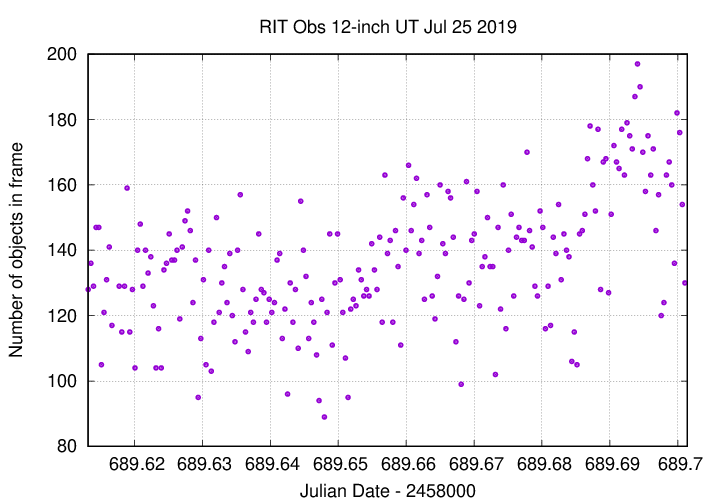
On the night of Jul 24/25, 2019, RIT physics major Evan Muskopf and I acquired a set of observations of the newly discovered WV Sge cataclysmic variable star TCP J21040470+4631129 (see also Astronomer's Telegram 12947 ).
The superhumps increased a bit in amplitude tonight.
The main setup was:
Notes from the night:
The object is located at
RA = 21:04:04.7 Dec = +46:31:12.9
A chart of the field is shown below. The size of the chart is about 21 by 15 arcminutes.

I've marked the location of several comparison stars, which also appear in light curves below.
star UCAC4 B V ---------------------------------------------------- A 683-095755 10.832 10.528 B 683-095722 11.142 10.948 C 683-095772 12.342 10.960 D 683-095866 12.814 12.414 E 683-095811 14.017 12.691 ----------------------------------------------------
When the telescope is pointed at the field, the finder scope's image on the television screen looks like this (North up, East left):

The dark current looked very much like last night, good since both were taken at T = -20 C.

The sky value shows only a small bump due to very light clouds.

Here's a record of the telescope's drift. I made no adjustments to the mount during the night.

The number of objects detected.

I used an aperture with radius 4.0 pixels. I made no changes to focus.

No sign of clouds in the image adjustment graph.

Using aperture photometry with a radius of 4 pixels (binned 2x2, each pixel is 1.34 arcsec, so a radius of 5.4 arcsec), I measured the instrumental magnitudes of a number of reference stars and the target. Following the procedures outlined by Kent Honeycutt's article on inhomogeneous ensemble photometry, I used all stars in a 600x600 pixel box around the target in each image to define a reference frame, and measured each star against this frame.
Sigma-vs-mag plots show that the floor was about 0.007 mag overall. I marked the brightest two stars in the ensemble as "variable," due to saturation.

Here are light curves of the variable and the field stars.

I used the UCAC value for the V-band magnitude of star "A" = UCAC4 683-095755 to shift the ensemble magnitudes to the standard V-band scale.
Here's a closeup of the variable and stars of similar magnitude.

You can download my measurements below. A copy of the header of the file is shown to explain the format.
# Measurements of TCPJ21040470+4631129 made at RIT Obs, UT 2019 Jul 25, # in good conditions, # by Michael Richmond and Evan Muskopf, # using Meade 12-inch LX200 and ATIK 11000. # Exposures 20 seconds long, V filter. # Tabulated times are midexposure (FITS header time - half exposure length) # and accurate only to +/- 1 second (??). # 'mag' is a differential magnitude based on ensemble photometry # using a circular aperture of radius 4 pix = 5.3 arcseconds. # which has been shifted so UCAC4 683-095755 has mag=10.528 # which is its V-band magnitude according to UCAC4. # # UT_day JD HJD mag uncert Jul25.11319 2458689.61319 2458689.61546 10.927 0.009 Jul25.11359 2458689.61359 2458689.61586 10.946 0.009
Last modified 7/25/2019 by MWR.